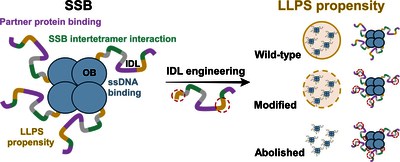Ecsédi, Péter and Érfalvy, Dávid and Kovács, Zoltán J and Kátrán, Viktória and Pálinkás, János and Cervenak, Miklós and Pancsa, Rita and Harami, Gábor and Smeller, László and Kovács, Mihály (2025) Selective engineering of condensation properties of single-stranded DNA binding (SSB) protein via its intrinsically disordered linker region. NUCLEIC ACIDS RESEARCH, 53 (11). No.-gkaf481. ISSN 0305-1048
|
Text
gkaf481.pdf - Published Version Available under License Creative Commons Attribution. Download (2MB) | Preview |
|
![[img]](https://real.mtak.hu/224320/7.hassmallThumbnailVersion/gkaf481figgra1.jpeg)
|
Text
gkaf481figgra1.jpeg - Published Version Available under License Creative Commons Attribution. Download (220kB) | Preview |
Abstract
Single-stranded DNA binding (SSB) proteins are essential components of genome metabolism in both bacteria and eukaryotes. Recently demonstrated condensation propensities have placed SSB functions in a new context regarding the organization of nucleic acid-modifying complexes. In this work, we provide functional dissection of the condensation and partner binding properties of Escherichia coli (Ec) SSB via engineered modifications of its intrinsically disordered linker (IDL) region. We identify specific alterations in two glycine-rich regions as well as aromatic and/or positively charged residues of the IDL by which a broad-range, selective modification of condensation propensity and condensate thermal and chemical stability can be achieved, while leaving the single-stranded DNA and partner protein binding functions of SSB unchanged. AlphaFold 3-predicted structures of tetrameric wild-type and engineered EcSSB constructs identify multiple possible binding sites for the conserved C-terminal tip on the tetramer core of the IDL, establishing a link between condensation propensity and restrictions in IDL conformational dynamics. Besides defining the contributions of IDL-driven interactions to driving protein condensation, these results pave the way for the definition of in vivo roles of EcSSB condensation via genetic engineering and delineate ways for further development of liquid–liquid phase separation prediction algorithms.
| Item Type: | Article |
|---|---|
| Subjects: | Q Science / természettudomány > QR Microbiology / mikrobiológia |
| SWORD Depositor: | MTMT SWORD |
| Depositing User: | MTMT SWORD |
| Date Deposited: | 16 Sep 2025 11:47 |
| Last Modified: | 16 Sep 2025 11:47 |
| URI: | https://real.mtak.hu/id/eprint/224320 |
Actions (login required)
 |
Edit Item |




